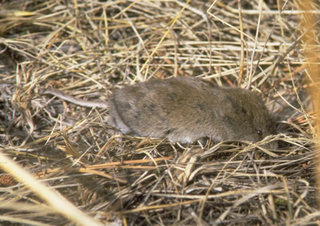
Long-tailed vole
Order : Rodentia
Suborder : Sciurognathi
Family : Muridae
Subfamily : Arvicolinae
Species : Microtus longicaudus
Keywords: tail , brown , green
The Long-tailed vole is listed as Least Concern (LR/lc), lowest risk. Does not qualify for a more at risk category. Widespread and abundant taxa are included in this category, on the IUCN Red List of Threatened Species
Some facts about the
Long-tailed vole
Adult weight : 0.037 kg (0.0814 lbs)
Litter size : 5
Litters per year : 2
Body mass : 0.033 kg (0.0726 lbs)
Temperature : 37.85 °C (100.13 °F)
Facts about the long-tailed vole
In the second plot, long-tailed voles are seen to dominate over brown lemmings during most of the sequence, but lemmings become dominant at the final approach of the Last Glacial Maximum.
leucophaeus (White-bellied, long-tailed vole) is a USFS Sensitive species, therefore has its own account 050826.
Long-tailed Vole is a 'pest' (an unwanted organism) that can be controlled through the use of pesticides.
Long-tailed voles are found in the driest parts of the meadows, montane voles in the more mesic areas where grasses, sedges, and forbs comprise a diverse community, and water voles in the immediate streamside area , their burrows often entering the bank at the water's edge.
Long-tailed voles are most commonly found in rocky situations on mountainsides but are also found in a wide range of habitats from low, wet, spruce woodland to high mountains (Youngman 1975).
The long-tailed vole (Microtus longicaudus) is a common resident of the herbaceous understory of many forests.
The long-tailed vole is an ideal model organism to examine the possible relationship between climate change and mammalian ecology because of its widespread geographic distribution (Fig.
Long-tailed voles are herbivores, eating plants, seeds, fruits, and the bark of trees and shrubs. (Full text)
The long-tailed vole is a large (six to eight inches in length, including the tail) mouse-like rodent with a long tail and dark gray fur. (Full text)
Microtus longicaudus is a montane forest species, usually associated with meadows and forest edge, and sometimes living in forest itself. (Full text)
Long-tailed Vole Microtus longicaudusHabitat: Long-tailed voles are most often associated with marshy to dry grassy areas adjacent to water in mountainous areas. (Full text)
Range in Colorado: The long-tailed vole is a common mammal over the mountain and plateau country of the western two-thirds of Colorado. (Full text)
The Long-tailed Vole is from the order Rodentia. (Full text)
They are pudgy, with blunt faces and small eyes, small and sometimes inconspicuous ears, short legs, and a short and scantily haired tail (the long-tailed vole is an exception). (Full text)
Northern water shrews, deer mice, and long-tailed voles are commonly present. (Full text)
Long-tailed voles are found in a wide variety of habitats such as sagebrush grasslands, forests, mountain meadows and banks of streams. (Full text)
Area of Distribution Long-tailed voles are found throughout the western United States and Canada up through southeastern Alaska. (Full text)
More animals beginning with L
